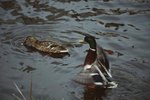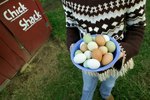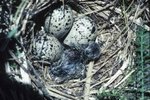
During the duck's earliest development period, his cells divide inside the egg both before and after it is laid. With his mother's incubation providing the warm environment he needs to grow, his body develops until he is a live and fully formed chick inside the egg -- but even then, he may not be ready to make his grand entrance by hatching.
Before the Laying
The earliest stages of development take place not just inside the egg, but inside the mother duck, or hen. There, the egg develops from the inside out, starting with the yolk -- this serves as a food source for the duck throughout his development, and around which the first cells form. These cells are called the gastrula, and over the course of the duck's incubation, they will develop to form the different parts of his body, like his lungs, muscles, nerves and skin. The last part of the duck's egg to develop before it is laid is the shell, which protects the duck inside and also provides the calcium that will form his bones. Once this layer is complete, the hen lays the egg.
The Laying Period
A hen only lays one egg per day, and she lays them all in the same place -- a nest of her own making. The hen prepares the nest over the course of several days as she lays her eggs one by one, and during this period, development is slow. This is because the hen wants her eggs to hatch at approximately the same time, so her offspring will be easier to manage. If she starts incubating them too early, the first-laid eggs will hatch before the later-laid eggs. The developing ducks are not particularly sensitive to the cold at this stage in their development, so until she is ready to incubate them all herself, she simply leaves them in the nest and shelters them from predators and the elements with besting material like grass and her own feathers, which she plucks out.
Incubation
The incubation period is when the duck develops inside his egg. His mother lays on his egg and the rest of the eggs at the same time, rotating them periodically so that they all benefit from the same amount of body heat. This heat causes the duck embryo's cells to divide, an approximately 21- to 28-day process during which the gastrula develops into a living duck. During this period, the duck gets oxygen through the pores of his shell and obtains all of the nutrients he needs from the yolk of the egg.
Pre-Hatching
As the hatching day approaches, the duck and his siblings are almost fully developed, and work to synchronize their hatching by communicating with each other from inside their eggs. From there, they can produce audible clicking sounds, which signal to less-developed ducks that they must speed up their metabolisms to catch up with developing. The hen may even join in with clucking sounds that send a similar message. This synchronization allows the eggs to hatch around the same time -- a time frame that lasts several hours, or even a full day.
References
Photo Credits
-
Stockbyte/Stockbyte/Getty Images
Writer Bio
Tom Ryan is a freelance writer, editor and English tutor. He graduated from the University of Pittsburgh with a degree in English writing, and has also worked as an arts and entertainment reporter with "The Pitt News" and a public relations and advertising copywriter with the Carnegie Library of Pittsburgh.




